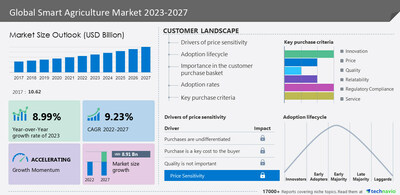This trend underscores a pivotal shift towards cost-effective yet cutting-edge technological solutions tailored to the needs of modern agricultural enterprises
To know about the vendor offerings - Request a sample report
The smart agriculture market is fragmented, and the degree of fragmentation will accelerate. The availability of low-cost cloud services encouraging the adoption of smart farming will offer immense growth opportunities. However, the High initial investment in smart farming technology will hamper the market growth.
The adoption of big data in smart farming is a major trend in the market.
Higher production levels can be achieved by improving wireless communication in the agricultural sector. Thus, this will lead to Equipment repair and maintenance. Furthermore, improved operational reliability in the field can also lead to higher crop production levels. Data collection and storage have become easier with the help of big data analytics. It also facilitates decision-making and other farmer practices. Therefore, increasing adoption of big data is expected to drive market growth during the forecast period
Therefore, increasing adoption of big data is expected to drive market growth during the forecast period
Segment Analysis
Segmentation Highlights
Analyst Review
In recent years, smart agriculture has emerged as a transformative force in the farming industry, leveraging advanced technologies to optimize growing conditions and enhance productivity. Cultivators worldwide are increasingly turning to innovative solutions, moving away from conventional farming methods towards a more efficient and sustainable approach.
One of the key components driving this shift is the adoption of LED grow lights, which offer superior energy efficiency compared to traditional lighting systems. By harnessing the power of LED technology, farmers can achieve optimal growth conditions while minimizing energy consumption and reducing costs.
Moreover, the integration of RFID tags and readers, along with infrastructural health sensors, enables precise monitoring and management of agricultural operations. These sensing devices provide real-time data on soil moisture, nutrient levels, and environmental conditions, empowering farmers to make data-driven decisions for soil maintenance, irrigation, and weed control.
Agricultural robots have also revolutionized farm labor management, automating tasks such as fruit picking, harvesting, planting, and plowing. Equipped with advanced guidance systems and RF technology, these robots operate seamlessly in the field, improving efficiency and reducing reliance on manual labor.
Source prnewswire






No Comments